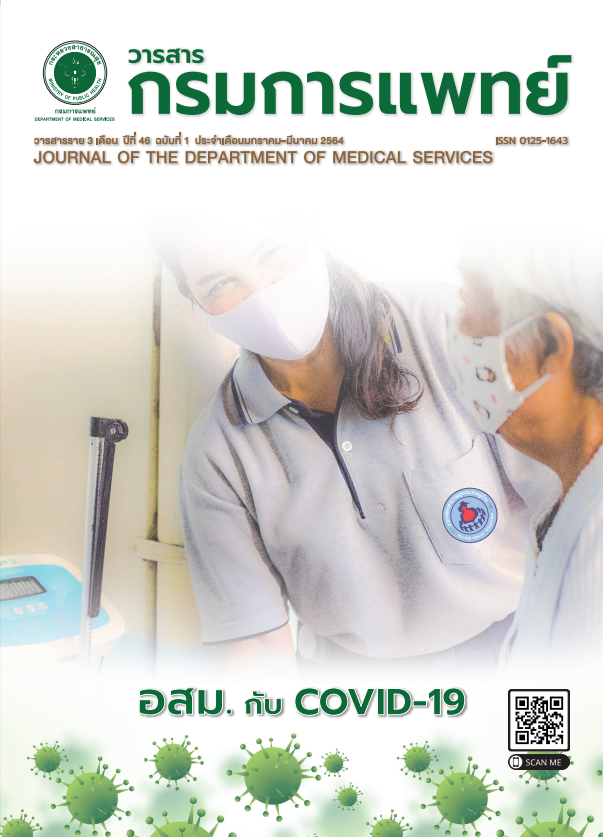Surgical Endodontic Retreatment with Mineral Trioxide Aggregate in Maxillary Central Incisor: a Case Report
Keywords:
Endodontic surgery, Surgical endodontic retreatment, Apicoectomy, Retrograde filling, Mineral Trioxide Aggregate, MTAAbstract
Endodontic surgery is one of dental procedures for treating persistent apical periodontitis in cases that have not responded to primary endodontic treatment. Post-treatment apical periodontitis may persist due to biological factors or when primary endodontic treatment has been ineffective in eliminating the intraradicular infection. It may not be appropriate to carry non-surgical endodontic retreatment. This case report was the report of 43 year-old woman with symptomatic apical periodontitis of maxillary right central incisor after primary endodontic treatment with post and bridge abutment restoration. Apical endodontic surgery was performed by apicoectomy and retrograde filling with mineral trioxide aggregate (MTA). MTA had been shown in a number of studies to be a potential root end filling material. After three year follow up, clinical examination showed that the teeth was asymptomatic. A periapical radiograph revealed complete healing of periapical tissue, rendering the successful treatment.
References
Salehrabi R, Rotstein I. Endodontic treatment outcomes in a large patient population in the USA: an epidemiological study.J Endod 2004; 30:846-50.
de Chevigny C, Dao TT, Basrani BR, Marquis V, Farzaneh M, Abitbol S, Friedman S. Treatment outcome in endodontics: the Toronto study—phases 4: initial treatment. J Endod 2008; 34:258-63.
Nair PN. On the causes of persistent apical periodontitis: a review.Int Endod J 2006; 39:249-81.
Kim S, Kratchman S. Modern endodontic surgery concepts and practice: a review. J Endod 2006; 32:601-23.
de Chevigny C, Dao TT, Basrani BR, Marquis V, Farzaneh M, Abitbol S, Friedman S. Treatment outcome in endodontics: the Toronto study—phases 3 and 4: orthograde retreatment. J Endod 2008;34:131-7.
Abbott PV. Incidence of root fractures and methods used for post removal. Int Endod J 2002; 35:63-7.
Torabinejad M, Corr R, Handysides R, Shabahang S. Outcomes of nonsurgical retreatment and endodontic surgery: a systematic review. J Endod 2009; 35:930–7.
Song M, Jung IY, Lee SJ, Lee CY, Kim E. Prognostic factors for clinical outcomes in endodontic microsurgery: a retrospective study. J Endod 2011; 37:927–33.
Wang N, Knight K, Dao T Friendman S. Treatment outcome in endodontics-the Toronto study. Phases I and II:apical surgery.J Endod 2004; 30:751-61.
Barone C, Dao TT, Basrani BB, Wang N, Knight K, Friendman S.Treatment outcome in endodontics: the Toronto study- Phases 3, 4, and 5: apical surgery. J Endod 2010; 36:28-35.
Gilheany PA, Figdor D, Tyas MJ. Apical dentin permeability and microleakage associated with root end resection and retrograde filling. J Endod 1994; 20:22-6.
Nair PNR, Henry S, Cano V, Vera J. Microbial status of apical root canal system of human mandibular first molars with primary apical periodontitis after “one-visit” endodontic treatment. Oral Surg Oral Med Oral Pathol Oral Radiol Endod 2005; 99:231-52.
Plotino G, Pamaijer CH, Grande NM, Somma F. Ultrasonics in endodontics: a review of the literature. J Endod 2007; 33:81-95.
Torabinejad M, Parirokh M. Mineral trioxide aggregate: a comprehensive literature review—part II: leakage and biocompatibility investigations. J Endod 2010; 36:190-202.
Torabinejad M, Watson TF, Pitt Ford TR. Sealing ability of a mineral trioxide aggregate when used as a root end filling material. J Endod 1993; 19:591-5.
Torabinejad M, Higa RK, MaKendry DJ, Pitt Ford TR. Dye leakage of four root end filling materials: effects of blood contamination.J Endod 1994; 20:159-63.
Fernández-Yáñez Sánchez A, Leco-Berrocal MI, Martínez-González JM. Metaanalysis of filler materials in periapical surgery.Med Oral Patol Oral Cir Bucal 2008; 13:E180-5.
Torabinejad M, Hong CU, Pitt Ford TR, Kettering JD. Cytotoxicity of four root end filling materials. J Endod 1995; 21:489-92.
Torabinejad M, Ford TR, Abedi HR, Kariyawasam SP, Tang HM.Tissue reaction to implanted root-end filling materials in the tibia and mandible of guinea pigs. J Endod 1998; 24:468-71.
Parirokh M, Torabinejad M. Mineral trioxide aggregate: a comprehensive literature review—Part I: chemical,physical,and antibacterial properties. J Endod 2010; 36:16-27.
Torabinejad M, Pitt Ford TR, McKendry DJ, Abedi HR, Miller DA, Kariyawasam SP. Histologic assessment of mineral trioxide aggregate as a root-end filling in monkeys. J Endod 1997; 23:225-8.
Chong BS, Pitt Ford TR, Hudson MB. A prospective clinical study of Minera Trioxide Aggregate and IRM when used as root-end filling materials in endodontic surgery. Int Endod J 2003; 36:520-6.
von Arx T, Hanni S, Jensen SS. Clinical results with two different methods of root-end preparation and filling in apical surgery:mineral trioxide aggregate and adhesive resin composite. J Endod 2010; 36:1122-9.
Öğütlü F, Karaca İ. Clinical and radiographic outcomes of apical surgery: a clinical study. J Maxillofac Oral Surg 2018; 17:75-83.
Alghamdi F, Alhaddad AJ, Abuzinadah S. Healing of periapical lesions after surgical endodontic retreatment: a systemic review.Cureus 2020; 12:e6916.
Downloads
Published
How to Cite
Issue
Section
License

This work is licensed under a Creative Commons Attribution-NonCommercial-NoDerivatives 4.0 International License.
บทความที่ได้รับการตีพิมพ์เป็นลิขสิทธิ์ของกรมการแพทย์ กระทรวงสาธารณสุข
ข้อความและข้อคิดเห็นต่างๆ เป็นของผู้เขียนบทความ ไม่ใช่ความเห็นของกองบรรณาธิการหรือของวารสารกรมการแพทย์



